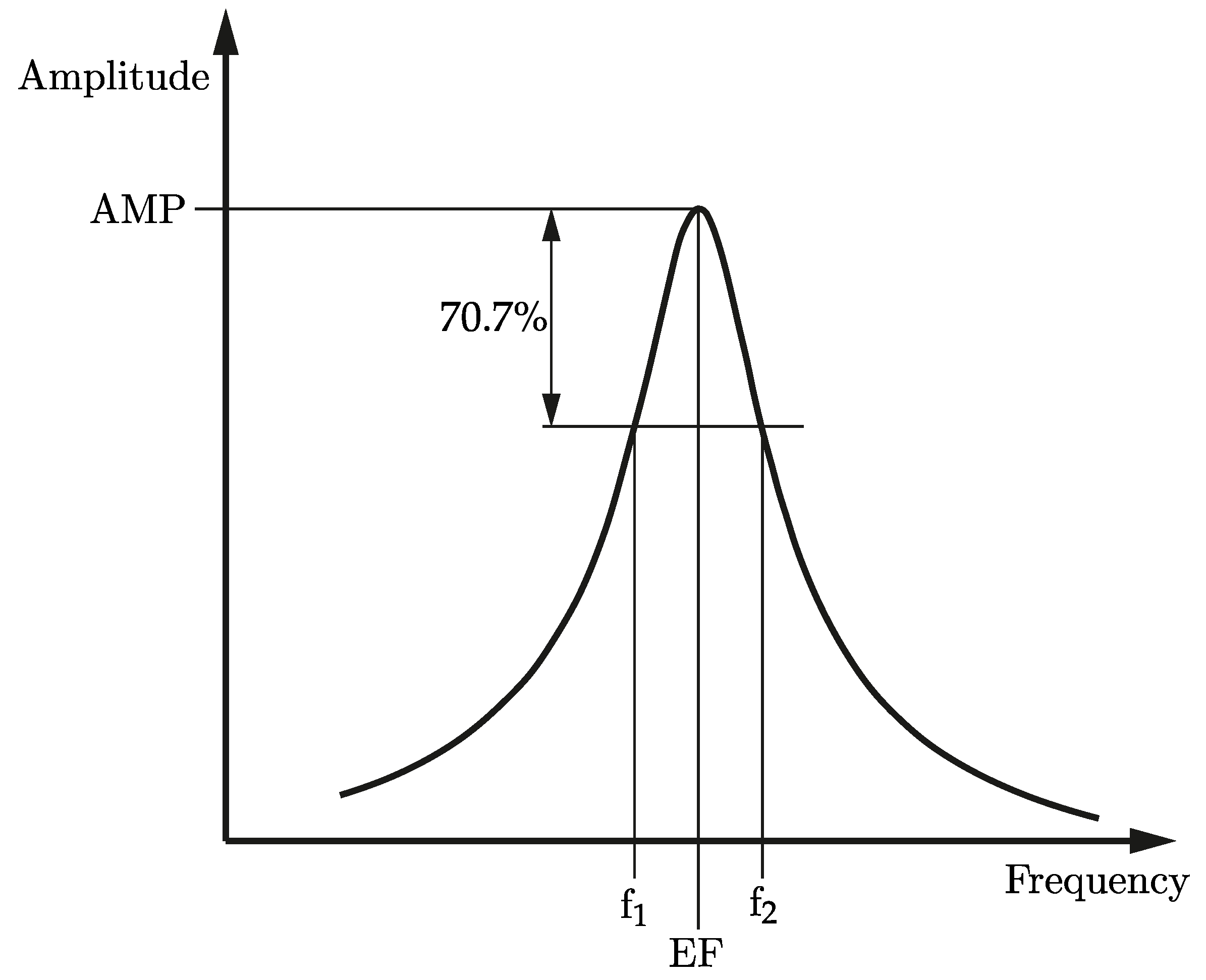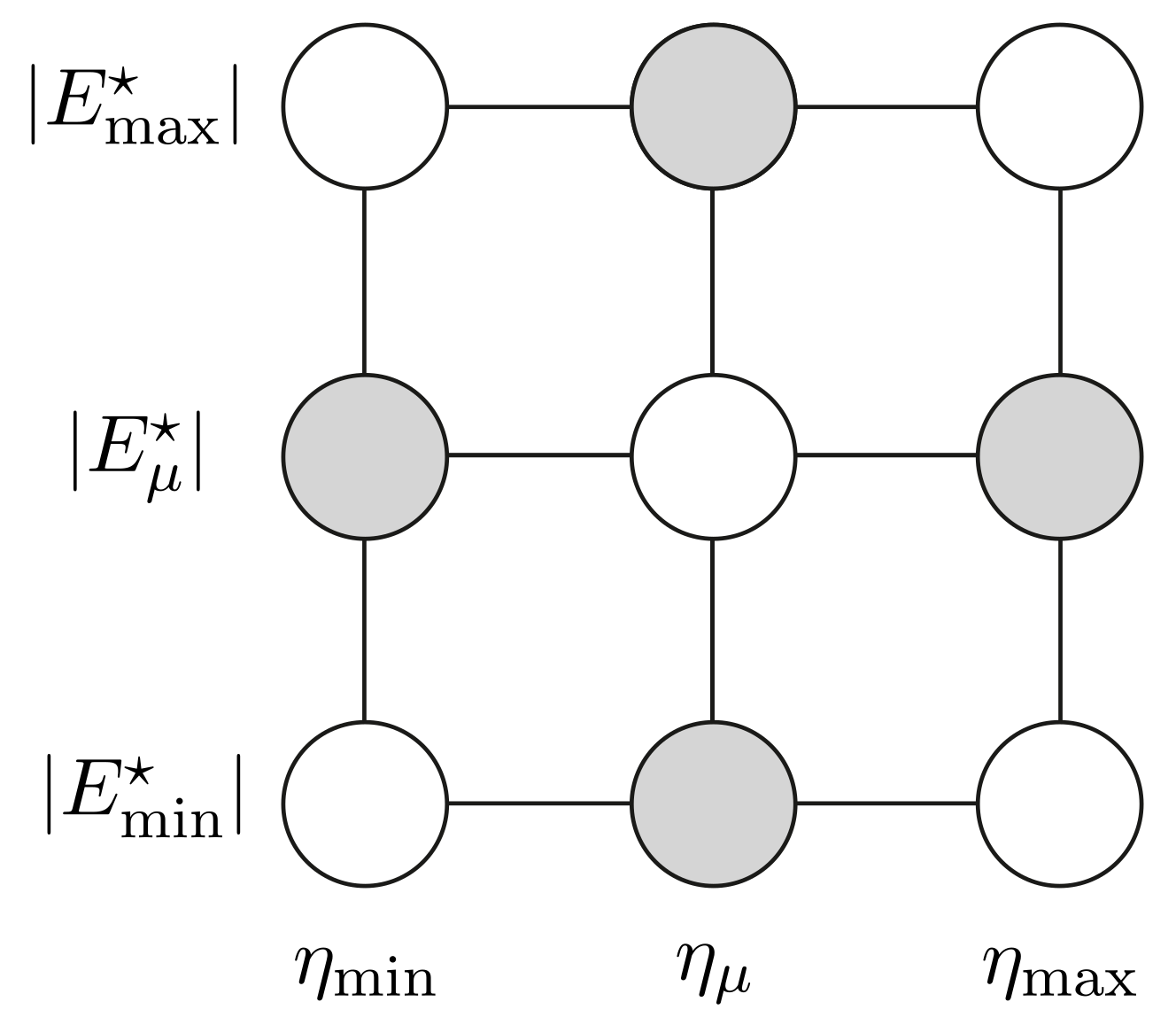1. Introduction
In modern engineering applications, advanced materials and material combinations are used to tackle vibration problems. In order to analyze such structures with a virtual model, an accurate representation of the structure, including geometric details, material characteristics, loading conditions etc., is required. While the geometric description is generally available from CAD data, the material parameters of the model are often unknown and have to be determined by comparison with measurement results.
For an appropriate description of the real structure, viscoelastic material behavior is often required. While a perfectly elastic material has three assumptions, namely the linearity, the simultaneity, and the unique equilibrium value between the stress and strain [
1], viscoelastic material models only require linearity [
1]. Rheological models for these materials can be illustrated as combinations of springs and dampers [
2]. In the present paper, the fractional Zener model is used, which is a modification of the traditional Zener model presented in [
3]. While the classical Zener model contains two springs and a dashpot [
4], the introduction of fractional calculus leads to a modification of the dashpot behavior, see, e.g., [
4,
5], and an additional fourth parameter, the fractional-order of the time derivative, is introduced [
6]. This modification allows for the representation of real materials with a low number of parameters [
6].
A possibility to estimate the parameters in the material model is through a minimization of the error between a numerical model and measurements. Different experimental setups are available to generate reference data for the minimization process. Quasi-static methods, such as the creep test and the relaxation test, analyze the behavior of the materials to an impulsive loading over a long time [
1], while dynamic methods consider the response to varying loads. According to [
7], the dynamic methods can further be categorized into the Dynamic Mechanical Analysis (DMA) [
8] and vibration tests [
9]. Several other techniques are listed in [
9], with a special focus on the estimation of damping.
The analysis of the material behavior by DMA is based on the measurement of the amplitude and the lag in the stress–strain relation caused by an oscillating force [
8]. Then, the parameters of the model, such as the modulus and the damping, can be calculated [
8]. In [
10], the viscoelastic material parameters of synthetic rubber are estimated by DMA. The damping of the test object is described by a Maxwell model, where two different specifications are compared [
10]. First, a series Maxwell setup containing 12 components and second, a fractional derivative model containing a springpot element instead of the dashpot is analyzed [
10]. In [
11], a unidirectional glass fibre-reinforced epoxy is investigated, where a three-point bending test including the effect of different temperatures of the test object is applied.
DMA leads to very good estimates for the material parameters, but expensive test equipment is required [
12] and the method is limited to low frequencies [
7]. Alternatively, vibration tests can be used to estimate the material properties. In [
7], a bare beam and a sandwich structure are analyzed by shaker tests. The Frequency Response Function (FRF) curve is used in a model updating process applying the amplitude correlation coefficient [
7]. The results are compared to those of DMA and show that the vibration test was found superior [
7]. In [
12], a setup containing two beams with different lengths is analyzed by impact hammer tests. The response is measured by an acceleration sensor and the complex Young’s modulus is estimated, based on the comparison of a calculated FRF of the beam and the measured response [
12].
Comparing the measured FRF curves with numerical data is also used by other researchers, like in [
13,
14,
15]. In [
13], isotropic and orthotropic material parameters are estimated from bending tests. Finite element (FE) simulations predict the viscoelastic material behavior and the Levenberg–Marquard algorithm is used for the estimation of the best fitting parameters [
13]. In [
14], a finite element model is applied to describe the test object containing a beam with a layer of viscoelastic damping material in a clamped-free boundary condition. The FRF curves are used to extract the values of the eigenfrequencies and amplitudes at these eigenfrequencies for the Parameter Identification Process [
14]. A two-step minimization is applied to estimate the best fitting parameters in combination with a parameter sensitivity analysis [
14]. In [
15], a viscoelastic composite plate is investigated. Amplitude values at the resonance frequency and close to the resonance frequency are used to fit the parameters [
15].
Generally, simple objects such as beams or plates are used in the process of material identification, since the modeling is less involved and the measurements are easier to conduct. Nowadays, various methods exist to solve one-dimensional structural problems, such as the Transfer Matrix Method, the Dynamic Stiffness Method or the Green function method [
16]. These methods involve a frequency-dependent system matrix that needs to be solved numerically [
16]. In the present paper, a (semi-)analytical method, named Numerical Assembly Technique (NAT), is used to describe one-dimensional beam structures. The method was introduced by Wu and Chou [
17] in 1999. NAT subdivides the beam structure into segments that contain a constant cross-section and constant material parameters [
16]. The homogeneous governing equations of the uniform beam segments are solved analytically and the resulting solutions are used to fit the boundary and interface conditions [
16].
Generally, the minimization process for the parameter identification requires numerous evaluations of the numerical models, which is a time-consuming process. In order to raise the efficiency of the Parameter Identification Process, the numerical model can be replaced by a surrogate model. Several surrogate modeling techniques exist, such as the Artificial Neural Network [
18,
19,
20,
21], parametric Reduced Order Model [
22], the Response Surface Method [
23] or the Polynomial Chaos Expansion (PCE) [
24,
25,
26,
27,
28]. In [
18,
19], a viscoelastic cylinder coated by water is analyzed and the complex Young’s modulus is estimated. An Artificial Neural Network is used as a surrogate model. In [
20,
21], a laminated structure is analyzed. The FRF curve gives the reference values and an Artificial Neural Network is used for the surrogate modeling process [
20,
21]. A Bayesian approach is applied for the estimation process [
20,
21]. In [
22], a reduction in the computational time is achieved by the reduction in the order of the model in order to efficiently estimate the complex shear modulus. In [
23], a Response Surface Method is used to describe the reference values based on the storage modulus and the loss factor. In [
24], a frictional system is analyzed and the Polynomial Chaos Expansion is used as a surrogate modeling technique. In [
25,
26], composite plates are analyzed and, based on the deviation of the results, the input parameters are chosen to describe the polynomial basis. In [
27,
28], a special combination of the Polynomial Chaos Expansion to estimate the material parameters [
27] and bearing stiffness parameters of a test rig [
28] is shown. The used method is called Polynomial Chaos Kriging and uses the Polynomial Chaos Expansion for a global system description and the Kriging method for the interpolation of local values [
29].
In the present work, PCE is used, which approximates the complex numerical model by orthonormal polynomials to reduce the computational load. PCE is based on the concept of Wiener [
30] and has been extended by Cameron and Martin [
31] using non-linear functions defined by a Fourier–Hermite series [
32,
33,
34]. Many refinements and new fields of applications for PCE have been investigated, which are summarized by Ghanem and Spanos [
32]. The aim of PCE is to span a space based on a polynomial basis and correlating coefficients in order to build a surrogate model [
34]. Depending on the distribution of the input parameters, different polynomials can be applied, as listed in, e.g., [
33].
The outline of the paper reads as follows: In
Section 2, the two numerical methods are explained, which build the basis for the Parameter Identification Process (PIP). In
Section 3, two examples are presented. First, a numerical example shows the efficiency and simplicity of the presented method. Second, a real measurement is used and the material and damping parameters are estimated. Finally, in
Section 4, the conclusion is presented.

















